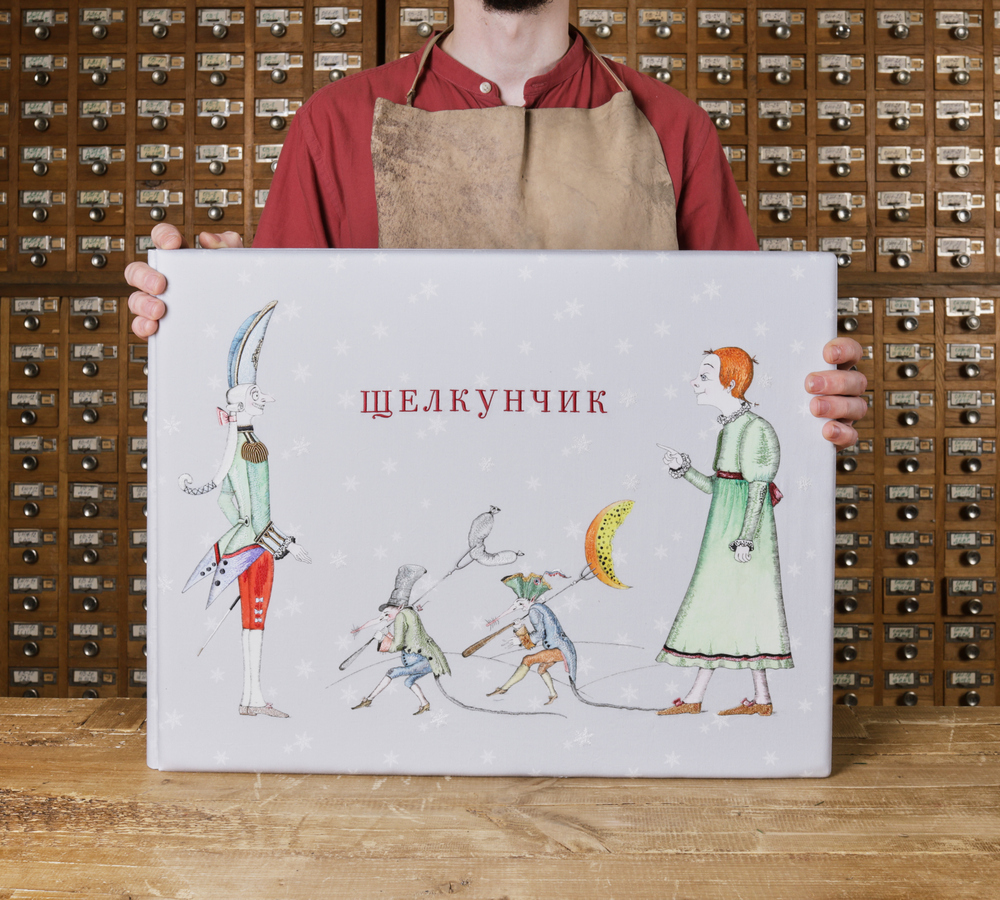THE NUTCRACKER
A bibliophilic edition of the ballet The Nutcracker, timed to marked the 20th anniversary of the legendary production of the ballet by the artist Mikhail Chemiakin. The book contains unique artistic-historical materials — a facsimile of a handwritten score of the ballet made by Tchaikovsky himself accompanied by sketches produced by the artist for the set-design of the production.
Additional information
Details of the creation of this masterpiece
-
Year of publication:2021
-
Number of pages:124
-
Dimensions:415 × 550 mm
-
Paper:Vélin d’Arches Rives (France), 280 g/m², handmade; Fabriano (Italy), 280 g/m², handmade литья; Somerset (England), 280 g/m², handmade
This edition features unique materials — a facsimile of a handwritten score of The Nutcracker made by Tchaikovsky himself accompanied by designs for the set of the legendary production made by the world-famous Russian artist Mikhail Chemiakin.
Tchaikovsky created The Nutcracker in 1891-1892 at the request of the administration of the Imperial Theatres. The composer took as the basis for the ballet the well-known story The Nutcracker and the Mouse King by the German writer E. T. A. Hoffmann.

It has since been staged by Yury Grigorovich, George Balanchine, Maurice Béjart, Matthew Bourne, Roland Petit and other choreographers. Many of them, especially Westerners, interpreted the ballet in a highly radical manner.
In 1999, Valery Gergiev, the artistic director of the Mariinsky Theatre, decided to have a new production of the ballet. On this occasion, the maestro invited to work on it someone who was not at all a theatrical designer — the sculptor and “easel artist” Mikhail Chemiakin.

Mikhail Chemiakin’s production of the ballet had its premiere in the Mariinsky Theatre on 12 February 2001. Ten years later, in 2011, the Rare Books from Saint Petersburg publishing house began work on the book Piotr Tchaikovsky. The Nutcracker. The first copy was completed in 2021, a round anniversary year for both the legendary production and the book project itself.

Creator of the illustrations, the handwritten libretto and the designs for the embroidery on the cover — Mikhail Chemiakin
Musical consultant — Sergei Stadler
Design of the cover — Mikhail Chemiakin, Piotr Suspitsyn
Layout — Yevgeny Grigoryev
Printing of the etchings — Fanny Boucher (France)
Printing of the score — Andrei Kuznetsov
Printing of the libretto — Ruslan Knyazev
Satin-stitch embroidery — Maria Rudkovskaya
Binding work — Andrei Degtev, Andrei Kulikov
Proof-reading — Natalia Nesterova
Project curator — Alexander Borodin
Tchaikovsky’s handwritten score was made available for the project by the Russian National Museum of Music (formerly the Glinka Museum).

When starting work on the new production of the ballet, Chemiakin first of all rewrote the libretto, going back to the primary source — Hoffmann’s story The Nutcracker and the Mouse King, because Petipa in his time, when constructing the plot of the future ballet, took as his basis not the original work, but the French translation made by Alexandre Dumas-père, which is three times the length of the prototype.
In the present publication, the libretto is a striking supplement to the illustrative material. It is reproduced in two forms: Chemiakin’s handwritten version and in type, repeating the text for ease of reading. The book contains 12 pages printed each side with text on a 19th-century German-made Dingler hand press.
In the designs that Mikhail Chemiakin produced for the ballet one can sense a style closely akin to Hoffmann the artist, who from an early age dreamed of a career as a professional draughtsman, but his grotesque style proved too unorthodox and ahead of his own time’s understanding of graphic art. The lightweight strokes in the sketches that Hoffmann made for the anthology Fantasy Pieces in the Manner of Callot possess a mocking ironical character and illustrate his own admission: “I wanted to work in the manner of Callot.”
As a result, the style of the outstanding master etcher Jacques Callot can be detected in the modern-day artist’s designs as a tribute to Hoffmann’s unaccomplished dream.

The different rodent classes are distinguished in the ballet by their costumes: the high society are elegantly decked out in robes, uniforms and smart frock coats, their heads crowned with splendid wigs; the commoner rats are, of course, less well dressed: “A frock coat, shirt, waistcoat, tricorn hat — all fairly worn out. The colours quite dim from age and dirt. They are clutching a string of stolen sausages and a bottle of wine.”

The endpapers are made from an Italian silk moiré and the book is kept in a case that is also finished with silk.

Additional information
Details of the creation of this masterpiece
-
Year of publication:2021
-
Number of pages:124
-
Dimensions:415 × 550 mm
-
Paper:Vélin d’Arches Rives (France), 280 g/m², handmade; Fabriano (Italy), 280 g/m², handmade литья; Somerset (England), 280 g/m², handmade
This edition features unique materials — a facsimile of a handwritten score of The Nutcracker made by Tchaikovsky himself accompanied by designs for the set of the legendary production made by the world-famous Russian artist Mikhail Chemiakin.
Tchaikovsky created The Nutcracker in 1891-1892 at the request of the administration of the Imperial Theatres. The composer took as the basis for the ballet the well-known story The Nutcracker and the Mouse King by the German writer E. T. A. Hoffmann.

It has since been staged by Yury Grigorovich, George Balanchine, Maurice Béjart, Matthew Bourne, Roland Petit and other choreographers. Many of them, especially Westerners, interpreted the ballet in a highly radical manner.
In 1999, Valery Gergiev, the artistic director of the Mariinsky Theatre, decided to have a new production of the ballet. On this occasion, the maestro invited to work on it someone who was not at all a theatrical designer — the sculptor and “easel artist” Mikhail Chemiakin.

Mikhail Chemiakin’s production of the ballet had its premiere in the Mariinsky Theatre on 12 February 2001. Ten years later, in 2011, the Rare Books from Saint Petersburg publishing house began work on the book Piotr Tchaikovsky. The Nutcracker. The first copy was completed in 2021, a round anniversary year for both the legendary production and the book project itself.

Creator of the illustrations, the handwritten libretto and the designs for the embroidery on the cover — Mikhail Chemiakin
Musical consultant — Sergei Stadler
Design of the cover — Mikhail Chemiakin, Piotr Suspitsyn
Layout — Yevgeny Grigoryev
Printing of the etchings — Fanny Boucher (France)
Printing of the score — Andrei Kuznetsov
Printing of the libretto — Ruslan Knyazev
Satin-stitch embroidery — Maria Rudkovskaya
Binding work — Andrei Degtev, Andrei Kulikov
Proof-reading — Natalia Nesterova
Project curator — Alexander Borodin
Tchaikovsky’s handwritten score was made available for the project by the Russian National Museum of Music (formerly the Glinka Museum).

When starting work on the new production of the ballet, Chemiakin first of all rewrote the libretto, going back to the primary source — Hoffmann’s story The Nutcracker and the Mouse King, because Petipa in his time, when constructing the plot of the future ballet, took as his basis not the original work, but the French translation made by Alexandre Dumas-père, which is three times the length of the prototype.
In the present publication, the libretto is a striking supplement to the illustrative material. It is reproduced in two forms: Chemiakin’s handwritten version and in type, repeating the text for ease of reading. The book contains 12 pages printed each side with text on a 19th-century German-made Dingler hand press.
In the designs that Mikhail Chemiakin produced for the ballet one can sense a style closely akin to Hoffmann the artist, who from an early age dreamed of a career as a professional draughtsman, but his grotesque style proved too unorthodox and ahead of his own time’s understanding of graphic art. The lightweight strokes in the sketches that Hoffmann made for the anthology Fantasy Pieces in the Manner of Callot possess a mocking ironical character and illustrate his own admission: “I wanted to work in the manner of Callot.”
As a result, the style of the outstanding master etcher Jacques Callot can be detected in the modern-day artist’s designs as a tribute to Hoffmann’s unaccomplished dream.

The different rodent classes are distinguished in the ballet by their costumes: the high society are elegantly decked out in robes, uniforms and smart frock coats, their heads crowned with splendid wigs; the commoner rats are, of course, less well dressed: “A frock coat, shirt, waistcoat, tricorn hat — all fairly worn out. The colours quite dim from age and dirt. They are clutching a string of stolen sausages and a bottle of wine.”

The endpapers are made from an Italian silk moiré and the book is kept in a case that is also finished with silk.

Piotr Tchaikovsky
THE NUTCRACKER
The story of the legendary production of the celebrated Russian ballet
Download presentation




























